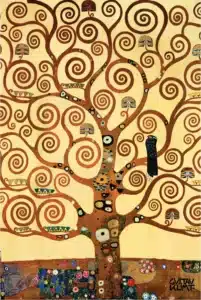Guest post by Elena Hirst Call, who enjoys expressing creativity through cross stitching, LEGOs, writing, and music.

Our Heavenly Parents are united in purpose. As Sister Susa Young Gates explained, “the divine Mother, side by side with the divine Father, [has] the equal sharing of equal rights, privileges and responsibilities” (The Vision Beautiful) Because of that unity in purpose, I want to examine: “I do nothing of myself; but as my Father hath taught me” (John 8:28) from the perspective of “I do nothing of myself; but as my Mother hath taught me.”
Christ elaborates, “The Son can do nothing of himself, but what he seeth the Mother do: for whatsoever things she doeth, these also doeth the Son likewise. For the Mother loveth the Son, and showeth him all things that Herself doeth…” (John 5:19-20, modified)
There are many things that Christ may have learned from our Heavenly Mother.
Sister Patricia Holland said, “in the ongoing process of creation—our creation and the creation of all that surrounds us—our heavenly parents are preparing a lovely tapestry with exquisite colors and patterns and hues” (Filling the Measure of Your Creation). Many have found textual evidence of the divine Feminine participating in the creation process, specifically identifying the spirit mentioned in Genesis 1:2 (My Search For The Divine Feminine, pg. 25) One of Christ’s main roles was the creator of worlds (Moses 2:1), a process that he was able to achieve with the guidance of our Heavenly Parents.
Creation is frequently referred to as a feminine act, particularly considering the role that women play in childbirth. Many scriptures refer to Christ bearing the world, our sorrows, and our grief. We find “Who his own self bare our sins in his own body on the tree” in 1 Peter (2:24), and in Isaiah, “Surely he hath borne our griefs, and carried our sorrows” (53:4). Christ asks us to partake of his body and blood, saying “Except ye eat the flesh of the Son of man, and drink his blood, ye have no life in you” (John 6:53). Similarly, mothers sustain babies with their own bodies in the process of breastfeeding, and medieval depictions of Christ often made that connection explicit (Feminine Images of Jesus).
The role that women have played in healing is not insignificant either. Through the early 1900s, women in the church performed healing rituals, taking an active part in blessing their communities (Rhetoric in Mormon Female Healing Rituals during the Nineteenth Century) Perhaps Christ learned how to heal our hearts and bodies from our Heavenly Mother as well. “In Jewish tradition, the tree of life was most commonly an olive tree, which makes sense given that tree’s important role in Middle Eastern culture. I have long thought it significant that we give healing blessings using consecrated olive oil, which is the fruit of the tree of life, therefore most appropriate to the task, and at least in part a symbol of our Mother’s nurturing concern for our health and well-being” (How to Worship our Mother in Heaven (without Getting Excommunicated)).
Trees are the most frequent metaphor used within the scriptures, and have a long history of association with the divine feminine. The tree of life in Lehi’s vision bore the fruit that comes from following Christ–eternal life. Elder Holland adds, “The images of Christ and the tree [are] inextricably linked” (Christ and the New Covenant). Nephi’s discussion with the angel in his own version of the vision, there is evidence that Nephi equated the tree with the virgin, and thus potentially the divine Feminine (Nephi and His Asherah). In ancient times, Asherah was seen as the wife of El, often typified as a tree (Nephi and His Asherah).
Christ may have learned wisdom from his Mother, as Wisdom was frequently used to refer to the divine Feminine. Her role as Wisdom is most defined in Proverbs. In chapter 8, Wisdom says, “All the words of my mouth are in righteousness . . . They are all plain to him that understandeth . . . Counsel is mine, and sound wisdom: I am understanding; I have strength.” Reaffirming Her role in creation, She explains she “was set up from . . . the beginning.” That “when [God] prepared the heavens, [she] was there,” and through all of creation, she “was by him, as one brought up with him: and [she] was daily his delight, rejoicing always before him.” (Lady Wisdom).
One of the most noteworthy of Christ’s actions is his efforts to reach out to women and others on the margins. Christ describes himself as a hen with us as chicks under His wings (Matthew 23:37), as well as a mother bear protecting her cubs (Hosea 13:8). His first appearance after his resurrection was to a woman (John 20), and women were the first people to know of his birth (Luke 1). He had compassion on women who had sinned (John 8), as well as women that didn’t belong to his ethnic group, such as the woman at the well (John 4).
In being asked to be like Jesus, we’re asked to embrace all characteristics of our Heavenly Parents. Although creation and healing are often seen as feminine, Christ’s example shows that everyone benefits from the godly attributes of both genders; men and women should both learn from Heavenly Mother’s example as Christ did.
This post is part of a series, Contemplating Heavenly Mother. Find more from this series here.






2 Responses
Thank you so much for these inspirational words. For a long time I both wanted to know my Heavenly Mother better and yet felt hesitant to do so. In doing some very serious thinking about this issue I realized that the reason I felt hesitation was because my relationship with my own mother was very rocky for so many years. I felt that I could never please her enough for her to actually love me, and when she was in a good mood she could suddenly become so mean and hurtful. I didn’t feel like I could trust her at all. These feelings I unconsciously projected onto Heavenly Mother to the point that I was afraid to know Her better for fear that she would act like my earthly mother had done for so much of my life.
This breakthrough was profound. When I realized that HM was like my dad’s mother who was the most loving, supportive, kind and empathetic person I’ve ever known and who was my champion and stood up for me to my mother when I was growing up I realized that I COULD completely love and trust Her and that I would always “be enough” for her and the battle inside me ceased.
It saddens me that the church leaders decided to do away with women giving blessings to each other and to their families and those who were in need. Whatever their reasoning was it was wrong. If anything we need to have this gift recognized and used more now than ever before.